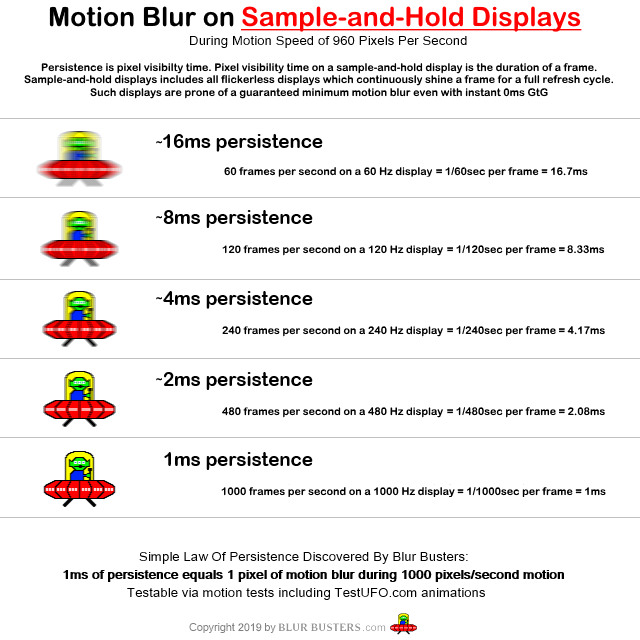Trackr wrote: ↑15 Jan 2021, 14:45
I've narrowed my options down to a 24" TN 1ms vs a 24" IPS 4ms (?)
Forget old IPS 4ms, stick to IPS 1ms. Although realworld is more than 1ms, even panels advertised as "1ms GtG IPS", are vastly faster than all past IPS panels not advertised as "1ms GtG". For non-esports players, IPS is now practically as good as TN nowadays.
Yes, yes, yes, TN is faster pixel response. But you have a 3007WFP! Perspective. The new IPS is 10x faster compared to your 3007WFP. TN is only barely 1.5x faster than the best IPS today. You're reading the picky esports stuff, but you have to consider you've got a 3007WFP, a very old IPS with
14ms pixel response (in some cases, >50ms realworld). Consequently, you'll get almost 100% of the pixel response upgrade staying IPS. So why not re-evaluate based on that reference? Once GtG is a tiny fraction of a Hz, the actual refresh rate is way more important for casual ergonomic reasons for your eyes.
Today's IPS has a real-world pixel response speed approximately 10x faster than the very old 3007WFP (from my eye's experience) so the TN-vs-IPS is insignificantly tiny on a relative basis on 3007WFP-versus-"Fast IPS".
You have the pros/cons (IPS glow versus TN viewing angles, etc) but your eyes are used to IPS, so I recommend the 1ms IPS panels.
Don't buy any IPS panel dated before year 2020. The "Fast IPS" technology are all 2020-models and newer, you will know it's one of the new faster IPS if it's
If you want the new fastest IPS, make sure:
(A) It is released in 2020 or later
(B) It is advertising "1ms GtG IPS" or "Fast IPS" or "NanoIPS"
Alternative Options:
1. Why not hit two birds with one stone?
Purchase a 27" NanoIPS (2560x1440) running at 165Hz. The color gamut is similar or better than the 3007WFP, with brilliant colors that look amazing in PhotoShop. I looked at 3007WFP and looked at say, XG270QG, and even for Visual Studio and Adobe Photoshop, I prefer losing 3 inches and a few pixel rows, to get the nice 165 Hz refresh rate combined with approximately 10x faster pixel response than the old 3007WFP. Almost having cake and eating it too. The only issue with XG270QG is that the KSF phosphor will add red-ghost if you use motion-blur-reduction mode (the flicker mode that allows a monitor to emulate a CRT -- see the
Motion Blur Reduction FAQ. But you probably don't need to worry about that because 3007WFP doesn't even have a motion blur reduction mode. Even merely just running 165Hz combined with the much faster "Fast IPS" panels -- gives you approximately one-third motion blur for scrolling/dragging/panning on an ViewSonic XG270QG or LG 27GL850, versus your old 3007WFP. These are all wide-color-gamut monitors, and NanoIPS improves on the color quality you're used to on your 3007WFP! And as a bonus, you get FreeSync/G-SYNC too which eliminates stuttering because it's a great eraser of single-framedrop stutter, see simulated animation at
www.testufo.com/vrr to see how small framedrops & framerate-changes becomes seamlessly stutter-free thanks to the magic of variable refresh rate... How would you love to have cake and eat it too, in one panel?? (as long as you don't mind losing 160 pixel rows).
2. Or why not consider 240Hz?
It's not just for esports anymore. 240Hz is also a visual pleasure. So if you're downgrading colors, why not max out your refresh rate to maximize your visual pleasure? Most 24" monitors are narrow-gamut so why not consider a 240Hz+ 1ms IPS monitor? 240Hz to futureproof better. Doubling Hz halves web browser scrolling motion blur, and quadrupling Hz gives you one-quarter web browser scrolling motion blur. You should keep an eye, for example, on the upcoming ViewSonic XG2431 or a similar 24" 240Hz IPS monitor.
Also, don't confuse GtG and MPRT pixel response times --
www.blurbusters.com/gtg-vs-mprt
How Much Will Refresh Rate Improvements Affect My Screen?
To understand the approximate amount of motion blur improvement you will see at
www.testufo.com here is a reference chart on how refresh rates will improve your web scrolling / map panning / window dragging / other movements.
This image below assumes GtG=0ms, framerate=Hz, and not using a motion blur reduction modes. So, therefore, it will actually be slightly bigger than this because your slow GtG means your 60Hz motion blur at
www.testufo.com is currently somewhat worse than this image below.
So your improvement going to 60Hz(14ms GtG) -> 165Hz(1ms GtG) may be closer to almost a 4x improvement in motion blur. Persistence (from limited refresh rate) and ghosting (slow GtG) combine to add extra blur/smear/ghosting.



